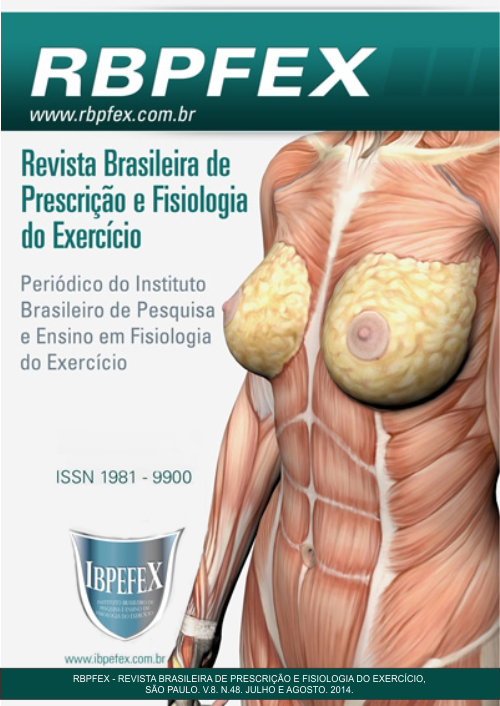Effects of hydro gymnastics on the increased strength of lower limbs of elderly women
Abstract
Introduction: During the aging process of the human organism has significant physiological changes, negatively affecting the control balance, strength and consequently predispose this population to the risk of falls. Despite the large number of elderly individuals practicing hydro gymnastics, there are few references in the literature addressing the responses this year. Aim: The aim of this study was to analyze the effects of hydro gymnastics on increased lower limb strength in older women. Materials and Methods: The sample consisted of 11 elderly women aged 55 to 71 years, regular practicing gymnastics. To evaluate the muscular strength of the legs to get up and sit in the chair 30 seconds standardization of Rikli and Jones (1999 ) cited by Matsudo (2000 ) before and after the 8-week program of training test was applied. Results: The overall response of the group was 43.96 % increase in lower limb strength, the average repetitions in evaluation 1 was 12.5, in the second test performed an average of 18 repetitions. Therefore the results obtained in this study showed significant differences in the increase of lower limb strength. Discussion: In performing the literature review studies that showed significant improvements in increasing muscle strength and others who had no positive results were found. Conclusion:Although this study demonstrated only a physiological variable, we can consider that the practice exercises for the elderly should be encouraged not only for cardiorespiratory development, but also for the improvement of muscle strength.
References
-American College of Sports Medicine –ACSM. Stand on Progression Models in Resistance Training for Healthy Adults. Medicine& Science in Sports & Exercise. Vol. 34. Núm. 2. p. 364-380. 2002.
-American College of Sports Medicine Progression Models in Resistance Training for Healthy Adults. Medicine & Science in Sports& Exercise: March. Vol. 41. Núm. 3. p. 687-708. 2009.
-Aguiar, J.B.; Gurgel, L.A. Investigação dos Efeitos da Hidroginástica sobre a Qualidade de Vida, a Força de Membros Inferiores e a Flexibilidade de Idosas: um Estudo no Serviço Social do Comércio de Fortaleza. Revista Brasileira de Educação Física. Vol. 23. Núm. 04. 2009.
-Alves, R.V.; Mota, J.; Costa, M.C.; Alves, J.G.B. Aptidão Física relacionada à Saúde de Idosos: Influência da Hidroginástica. Revista Brasileira de Medicina do Esporte. Vol. 10. Núm. 1. p. 31-7. 2004.
-Bompa, T.O. Treinamento de Potência para o Esporte: Pliometria para o Desenvolvimento de Potência.Phorte. 2004.
-Carroll, T.J.; Riek, S.; Carlson, R.G. Neural Adaptations to Resistance Training: Implications for Movement Control. Sports Medicine. Vol. 31. Núm. 12. p. 829-840. 2001.
-Castro, C.B.; Assumpção, C.O.; Neto, J.B.; Asano, R.Y. Efeitos da Prática da Hidroginástica nas Capacidades Físicas de Mulheres de 44 a 59 anos de Idade. Anuário da Produção Acadêmica Docente. Vol. 12. Núm. 2. p. 105-117. 2008.
-Costa, G.; Afonso, S.; Bragada, J.A.; Reis, V.M.; Barbosa, T.M. Estudo Comparativo das Adaptações Fisiológicas Agudas durante a execução de três variantes de um Exercício Básico de Hidroginástica. Revista Brasileira de Cineantropometria e Desempenho humano. Vol. 10.. Núm. 4. p. 323-329. 2008.
-Cruz, D.T.; Ribeiro, L.C.; Vieira, M.T.; Teixeira, M.T.B.; Bastos, R.R.; Leite, I. C.G. Prevalência de Quedas e Fatores Associados em Idosos. Revista Saúde Pública. Vol. 46. Núm. 1. p. 138-46. 2012.
-Di Masi, F. Desenvolvimento de Força nas Musculaturas Envolvidas na Extensão da Articulação do Joelho, em Mulheres Maduras, após um Programa Sistemático de Exercício Aquático Localizado. TCC. Departamento de Pós-Graduação da Universidade Castelo Branco. Rio de Janeiro. 1999.
-Elias, R.G.M.; Gonçalves, E.C.A.; Moraes, A.C.F.; Moreira, C.F.; Fernandes, C.A. M. Aptidão Física Funcional de Idosos Praticantes de Hidroginástica. Revista Brasileira de Geriatria e Gerontologia. Vol. 15. Núm. 1. p. 79-86. 2012.
-Fleck, S.J.; Kraemer, W.J.; Evans, W.J. Strength and Power Training: Physiological Mechanisms of Adaptation. Exercise Sports Science Review. Vol. 24. p. 363-397. 1996.
-Fleck, S.J.; Kraemer, W.J. Fundamentos do Treinamento de Força Muscular. Artmed.2006.
-Kruel, L.F.M.; Barella, R.E.; Graef, F.; Brentano, M.A.; Figueiredo, P.P.; Cardoso, A.; Severo, C.R. Efeitos de um Treinamento de Força Aplicado em Mulheres Praticantes de Hidroginástica. Revista Brasileira de Fisiologia do Exercício. Vol. 4. Núm. 1. 2005.
-Matsudo, S.M.M.; Matsudo, V.K.R.; Barros, N.T.L. Evolução do Perfil Neuromotor e Capacidade Funcional de Mulheres Fisicamente Ativas de acordo com a Idade Cronológica. Revista Brasileira de Medicina do Esporte. Vol. 9. Núm. 6. p. 365-376. 2003.
-Matsudo, S.M.M. Avaliação do Idoso: Física e Funcional. São Caetano doSul: Ed. Celafiscs Publicações. p. 40 e 41, p. 43, 44,69. 2000.
-Nayak, N.N.; Randall, K.; Shankar, K. Exercício para os Idosos. Prescrição de Exercícios. Campus.2002.
-Pinto, L.G.; Dias, R.M.R.; Salvador, E,P.; Júnior, A.F.; Lima, C.V.G. Efeito da utilização de Bandas Elásticas durante aulas de Hidroginástica na Força Muscular de Mulheres. Revista Brasileira de Medicina do Esporte. Vol. 14. Núm. 5. p. 450-453. 2008.
-Santarem, J.M. Fisiologia do Exercício e Treinamento Resistido na Saúde, na Doença e no Envelhecimento. Centro de Estudos em Ciência da Atividade Física da Faculdade de Medicina da USP. 2007.
Authors who publish in this journal agree to the following terms:
- Authors retain the copyright and grant the journal the right of first publication, with work simultaneously licensed under the Creative Commons Attribution License BY-NC which allows the sharing of the work with acknowledgment of the authorship of the work and initial publication in this journal.
- Authors are authorized to enter into additional contracts separately for non-exclusive distribution of the version of the work published in this journal (eg, publishing in institutional repository or book chapter), with acknowledgment of authorship and initial publication in this journal.
- Authors are allowed and encouraged to post and distribute their work online (eg, in institutional repositories or on their personal page) at any point before or during the editorial process, as this can bring about productive change as well as increase impact and impact. citation of published work (See The Effect of Free Access).






